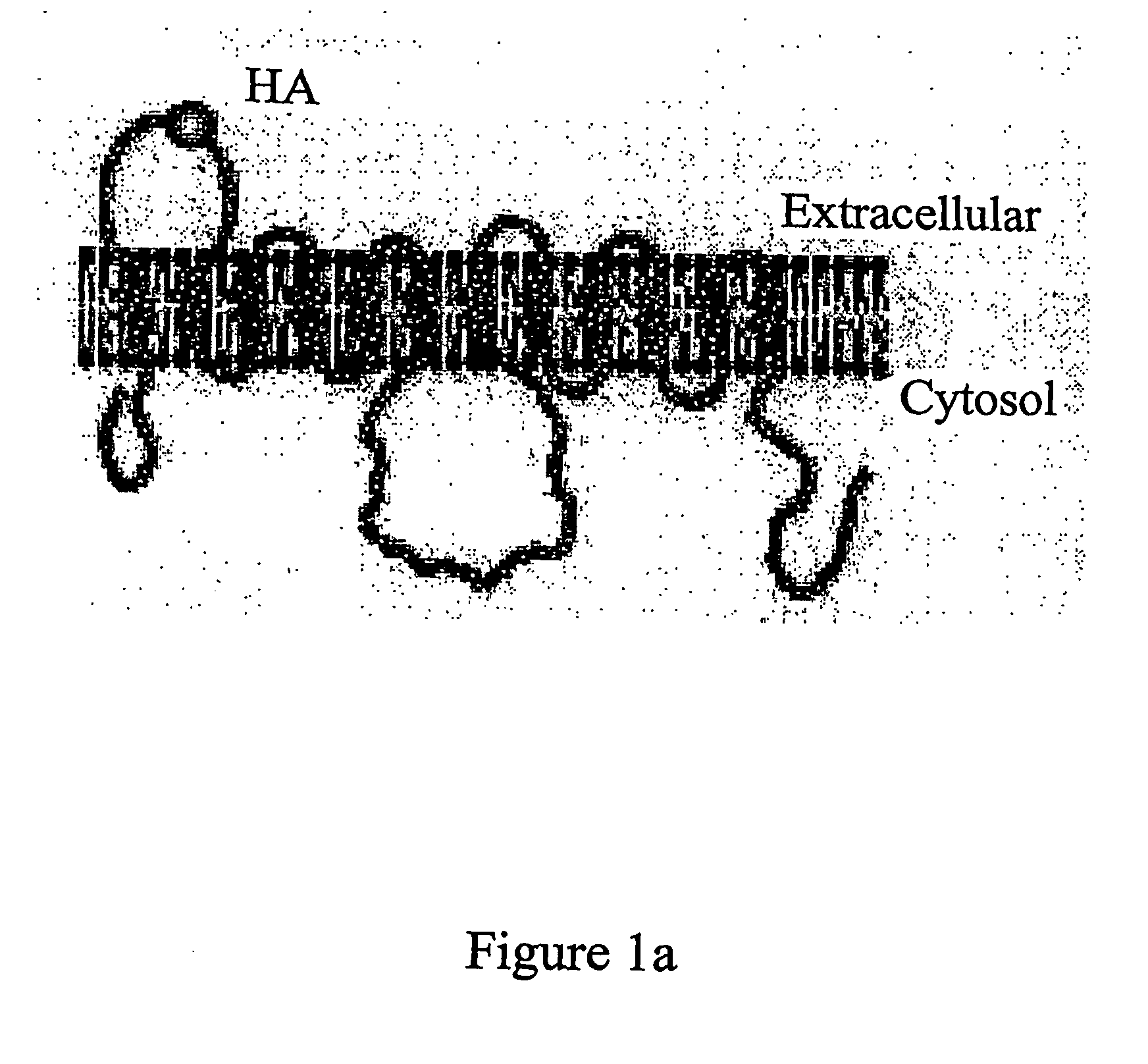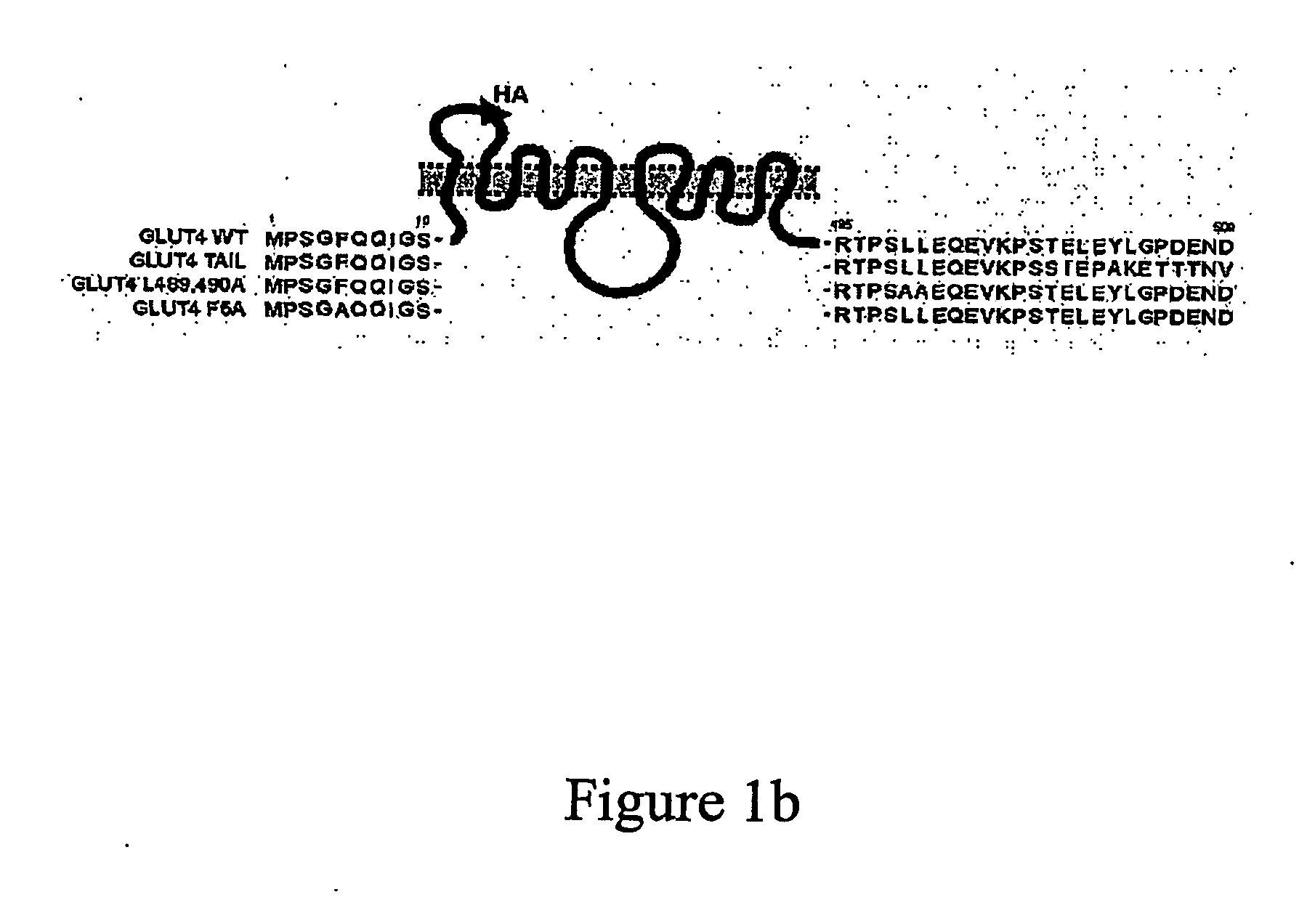Novel translocation assay
a translocation assay and translocation technology, applied in the field of in vitro translocation assay, can solve the problems of limiting the transport of substrates (both naturally occurring substrates and small molecules) into and/or outside the cell, nephrogenic diabetes insipidus, and inconvenient methods, so as to increase the level of mutant membrane transport protein, reduce the rate of recycling or transporter internalization
- Summary
- Abstract
- Description
- Claims
- Application Information
AI Technical Summary
Benefits of technology
Problems solved by technology
Method used
Image
Examples
example 1
Generation and Expression of a labeled GLUT4 Protein
[0569] A HA-tagged GLUT4 protein was produced essentially as described in Quon et al., Proc. Natl. Acad. Sci USA 94: 5587-5591, 1994. Essentially, the cDNA encoding GLUT4 was digested with SauI and a double stranded oligonucleotide was inserted by ligation. The double stranded oligonucleotide was formed by hybridizing two oligonucleotides one comprising the sequence TGAGATCGATTATCCTTATGATGTTCCTGATTATGG (SEQ ID NO: 63) and the other TCA GCA TAA TCA GGA ACA TCA TAA GGA TAA TCG ATC (SEQ ID NO: 64). The inserted nucleic acid encodes a HA tag between amino acids 67 and 68 in the first exofacial loop of GLUT4 (SEQ ID NO: 4). This gene construct was inserted into the vector pBABE (Pear et al. Proc. Natl Acad Sci. U.S.A. 90: 8392-8396 1993). The polypeptide encoded by this protein is shown schematically in FIG. 1A.
[0570] Additional gene constructs were generated comprising a nucleic acid encoding mutant forms of GLUT4 (these constructs e...
example 2
Generation of an Assay to Determine the Localization of GLUT4
[0577] 2.1 Methods
[0578] Retrovirally-transduced fibroblasts expressing HA-tagged GLUT 4 or a mutant therof were differentiated into adipocytes essentially as described above. These adipocytes were then subcultured for 30 hours. Insulin was then added at different time points, after which the cells were fixed in 3% formaldehyde. After washing and quenching with 50 mM glycine, cells were incubated for 20 min with 5% normal swine serum (NSS) in the absence or presence of 0.1% saponin to analyse the level of GLUT4 at the plasma membrane (PM) or the total cellular GLUT4 content, respectively. Cells were incubated for 60 min with a saturating concentration of either an antibody directed against the HA tag or a control non-relevant antibody (mouse IgG MOPC21) in PBS containing 2% NSS. After extensive washing, the cells were incubated for 20 min with 5% NSS in the presence or absence of 0.1% saponin to permeabilize all cells. C...
example 3
Insulin Induced Translocation of GLUT4 in 3T3-L1 Fibroblasts and Adipocytes
[0581] In fibroblasts, insulin induced the translocation of wild-type GLUT4 and each of the GLUT4 mutants to the PM (FIG. 3). The maximum level of surface GLUT4 was reached after 6 min of insulin stimulation, representing a 5-fold increase above that observed in non-stimulated cells, followed by a rapid reduction. The PM level of the GLUT4 F5A mutant was slightly higher than that of the other GLUT4 molecules in insulin-stimulated fibroblasts. In adipocytes we observed an ˜8-fold increase in cell surface GLUT4 levels in response to insulin stimulation. Neither wild-type GLUT4 nor any of the GLUT4 mutants showed an overshoot as was observed in fibroblasts. The GLUT4 TAIL mutant showed translocation characteristics similar to those of GLUT4 WT, although cell surface levels in both the absence and presence of insulin were increased by approximately 5%, in accordance with previous studies (Shewan et al., Mol. Bio...
PUM
| Property | Measurement | Unit |
|---|---|---|
| pH | aaaaa | aaaaa |
| density | aaaaa | aaaaa |
| concentrations | aaaaa | aaaaa |
Abstract
Description
Claims
Application Information
 Login to View More
Login to View More - R&D
- Intellectual Property
- Life Sciences
- Materials
- Tech Scout
- Unparalleled Data Quality
- Higher Quality Content
- 60% Fewer Hallucinations
Browse by: Latest US Patents, China's latest patents, Technical Efficacy Thesaurus, Application Domain, Technology Topic, Popular Technical Reports.
© 2025 PatSnap. All rights reserved.Legal|Privacy policy|Modern Slavery Act Transparency Statement|Sitemap|About US| Contact US: help@patsnap.com



